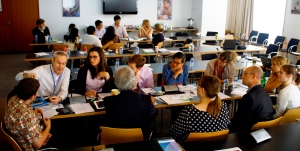
Guest author: Zoë Cullen, Senior Programme Manager at Fauna & Flora International
Every good solution starts with a problem.
At the Forests Asia Summit last week, a wealth of intellectual capital came together to discuss the pressing global problem of tropical deforestation and the need to develop holistic solutions to reduce forest loss while enabling equitable and sustainable economic growth. In essence, how to transition to a Green Economy, or “Enterprise Earth” as aptly described by H.E. Heru Prasetyo, Head of the Indonesia National REDD+ Agency.
My personal experience of this challenge stems from working with Fauna & Flora International’s team in western Jambi Province, Indonesia. Here many adat (customary) communities have a strong desire to sustainably manage these carbon and biodiversity-rich forests as “village forest”. But support is needed to do this and to increase the productivity, value and sustainability of their agriculture-based economy to help ensure that rural economic development is not tied to forest loss.
This theme is replicated across Indonesia and globally. Beyond smallholder agriculture, such evolutions of practice are needed by agricultural producers at all scales and across sectors. How do we stimulate and finance this transition? What are the sources of finance and in what smart ways can they be deployed to drive results?
Donor funding alone will not suffice. The gap in funds available to pay for REDD+ and other conservation efforts is well documented. Private sector finance needs to be part of the solution.
The UNEP Finance Initiative and the UNDP Green Commodities Programme convened a workshop in Jakarta, with the support of UNORCID, on behalf of the UN-REDD Programme to discuss the use of results-based finance for REDD+. Essentially this is finance that rewards achievement of certain desired impacts, such as forest conservation, and there are many potential variations of results-based payments.

Participants of the UN-facilitiated results-based REDD+ workshop at the Forests Asia Summit, in May 2014.
There has been much talk of green bonds that generate capital to invest in commercially viable green investments. They offer enormous potential to drive sustainable investments in commodity supply chains, for example. Recent work by ForestTrends highlights the potential for jurisdictional REDD+ bonds to support forest conservation and development of sustainable agricultural supply chains across an administrative landscape, such as a state or province.
Thinking back to my community forest example, I’m particularly inspired by the potential of the “development impact bond” model that repays bond investors using long-term donor commitments. Applied to forests, a “rainforest impact bond” could be used to make significant funding available up-front to support diverse REDD+ activities such as clarification of forest tenure, investment in more sustainable and productive agriculture practices, and forest protection.
Up-front certainty of multi-year funding would enable implementing agencies to offer results-based contracts at the field level that could be much longer than traditional grant cycles permit. This, in turn, would provide greater certainty to the beneficiaries of those contracts and sufficient time to support development of green economic activities designed to deliver sustained benefits to communities beyond the lifetime of the bond.
While this approach to results-based finance is still dependent on donor funds, it introduces the private sector as key part of the story.
For every potential advantage of these approaches, I recognise the challenges and as yet unanswered questions: the distribution and management of risk, defining the size, form and timing of results-based payments, ensuring equity and trust, and measuring impact, to mention but a few.
Yet, as Nelson Mandela once said, “It always seems impossible until it’s done”. Similar methods have already been used to great effect by the International Finance Facility for Immunisations (IFFIm) to scale up vaccine delivery in the world’s poorest countries.
Last week’s workshop advanced an important discussion about the role and use of results-based finance mechanisms in the context of REDD+. There is much work to do to turn these approaches into real and appropriate solutions, at a scale in keeping with the size of the problem. Like other elements of REDD+ it will require true cross-sector collaboration and design of mechanisms that are carefully tailored to the local context where results-based finance will be deployed. But if there was one over-riding message I took from the group it was – when it comes to designing these mechanisms…keep it simple stupid!
The rewards of success will be great, as we strive towards what Pavan Sukhdev (UNEP Goodwill Ambassador) described as the “Holy Grail of REDD+”, a green economy in which sustainable management of forest, crop and grazing lands sustains all the major ecosystem services on which we all depend.
 Bio: Zoë Cullen is a Senior Programme Manager at Fauna & Flora International. She oversees the Innovative Conservation Finance programme within the Environmental Markets team, which seeks to identify and develop sustainable finance mechanisms for biodiversity conservation. Much of her recent work has focused on REDD+, particularly in Indonesia. Bio: Zoë Cullen is a Senior Programme Manager at Fauna & Flora International. She oversees the Innovative Conservation Finance programme within the Environmental Markets team, which seeks to identify and develop sustainable finance mechanisms for biodiversity conservation. Much of her recent work has focused on REDD+, particularly in Indonesia.
|